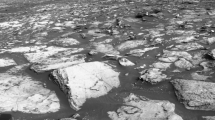Abstract
The High-Resolution Imaging Camera (HiRIC) is one major payload of China’s first Mars exploration mission, and its main objective is to obtain the detailed observation images of the key areas on the Martian surface. In this paper, the leading group of HiRIC shows a full blueprint of the HiRIC. The HiRIC can achieve a high resolution (0.5 m at an altitude of 265 km) with a wide swath width of 9 km. The HiRIC adopts an Off-Axis Three-Mirror Astigmatic (TMA) optical system with a focal length of 4640 mm, an F-number of 12 and a Field of View (FOV) of 2° × 0.693°. In order to reduce the instrument weight, carbon-based material is widely used in the opto-mechanical structure which is in ultra-lightweight design, thus, a light-weight camera with a total mass of 42 kg is obtained. The Time Delay and Integration (TDI) Charge Coupled Devices (CCDs) and Complementary Metal-Oxide-Semiconductor Transistor (CMOS) detectors are all set on the imaging plane to achieve the push-broom imaging and frame imaging, respectively. And the high Signal-to-Noise Ratio (SNR) >100:1 can achieve in multi observation types for various scientific imaging tasks. After 4-year design and fabricate, the HiRIC has been assembly. The testing results show that the instrument is in good condition, and the Modulation Transfer Function (MTF) can achieve 0.18 at Nyquist frequency. The HiRIC can achieve a well image on China first Mars exploration mission.































Similar content being viewed by others
References
N. Barlow, Mars: An Introduction to Its Interior, Surface and Atmosphere (Cambridge University Press, New York, 2014)
J. Bell III, S. Squyres, R. Arvidson et al., Pancam multispectral imaging results from the Spirit rover at Gusev crater. Science 305(5685), 800–806 (2004a)
J. Bell III, S. Squyres, R. Arvidson et al., Pancam multispectral imaging results from the Opportunity Rover at Meridiani Planum. Science 306(5702), 1703–1709 (2004b)
D. Blake, R. Morris, G. Kocurek et al., Curiosity at Gale crater, Mars: characterization and analysis of the Rocknest sand shadow. Science 341(6153), 1239505 (2013)
N. Bondarenko, I. Dulova, Y. Kornienko, Topography of polygonal structures at the Phoenix landing site on Mars through the relief retrieval from the HiRISE images with the improved photoclinometry method. Sol. Syst. Res. 48(4), 243–258 (2014)
M.H. Carr, The Surface of Mars (Cambridge University Press, New York, 2007)
L. Donald, W. James, A. Martin et al., An overview of the instrument suite for the Deep Impact mission. Space Sci. Rev. 117, 43–93 (2005)
C. Dundas, A. McEwen, S. Diniega et al., New and recent gully activity on Mars as seen by HiRISE. Geophys. Res. Lett. 37(7), L07202 (2010)
T. Ebben, J. Bergstrom, P. Spuhler et al., Mission to Mars: the HiRISE camera on-board MRO, in Proc. SPIE 6690, Focal Plane Arrays for Space Telescopes III, vol. 66900B (2007)
R. Fergason, R. Kirk, G. Cushing et al., Analysis of local slopes at the InSight landing site on Mars. Space Sci. Rev. 211(1–4), 109–133 (2017)
Y. Gao, B. Zhang, Design and analysis for the flexible support structure of high precision lens assembly. Optik, Int. J. Light Electron Opt. 175, 228–236 (2018)
M. Golombek, J. Grant, D. Kipp et al., Selection of the Mars Science Laboratory landing site. Space Sci. Rev. 170(1–4), 641–737 (2012)
M. Golombek, D. Kipp, N. Warner et al., Selection of the InSight landing site. Space Sci. Rev. 211(1–4), 5–95 (2017)
J. Grotzinger, D. Sumner, L. Kah et al., A habitable Fluvio-Lacustrine environment at Yellowknife bay, Gale crater, Mars. Science 343(6169), 1242777 (2014)
J.R. Irons, J.L. Dwyer, J.A. Barsi, The next Landsat satellite: The Landsat Data Continuity Mission. Remote Sens. Environ. 122, 11–21 (2012)
N. Iwata, T. Usui, A. Miki et al., Thermal control design of X-ray astronomy satellite ASTRO-H, in 42nd International Conference on Environmental Systems (2012), p. 3579
L. Keszthelyi, W. Jaeger, A. McEwen et al., High Resolution Imaging Science Experiment (HiRISE) images of volcanic terrains from the first 6 months of the Mars Reconnaissance Orbiter primary science phase. J. Geophys. Res., Planets 113(E4), E04005 (2008)
R. Kirk, E. Howington-Kraus, M. Rosiek et al., Ultrahigh resolution topographic mapping of Mars with MRO HiRISE stereo images: meter-scale slopes of candidate Phoenix landing sites. J. Geophys. Res., Planets 113(E3), E00A24 (2008)
A. Lefort, P. Russell, N. Thomas et al., Observations of periglacial landforms in Utopia Planitia with the High Resolution Imaging Science Experiment (HiRISE). J. Geophys. Res., Planets 114(E4), E04005 (2009)
A. McEwen, E. Eliason, J. Bergstrom et al., Mars reconnaissance orbiter’s High Resolution Imaging Science Experiment (HiRISE). J. Geophys. Res., Planets 112(E5), E05S02 (2007)
A. McEwen, C. Hansen-Koharcheck, A. Espinoza, Mars: The Pristine Beauty of the Red Planet (University of Arizona Press, Tucson, 2017a)
A. McEwen, F. Rocard, X. Barral, Mars: Une exploration photographique (Editions Xavier Barral, Paris, 2017b)
Q. Meng, H. Wang, W. Wang et al., Desensitization design method of unobscured three-mirror anastigmatic optical systems with an adjustment-optimization-evaluation process. Appl. Opt. 57(6), 1472–1481 (2018)
S. Murchie, R. Arvidson, P. Bedini et al., Compact Reconnaissance Imaging Spectrometer for Mars (CRISM) on Mars Reconnaissance Orbiter (MRO). J. Geophys. Res., Planets 112, E05S03 (2007)
Funding
Supported by Beijing Municipal Science and Technology Commission (No. Z191100004319001); the National Natural Science Foundation of China (61705220, 11703027 and 42001345); the Youth Innovation Promotion Association, Chinese Academy of Sciences (2019219); the Specialized Research Fund for Shandong Provincial Key Laboratory; and the grant from Key Laboratory of Lunar and Deep Space Exploration, Chinese Academy of Sciences (LDSE201901).
Author information
Authors and Affiliations
Corresponding authors
Additional information
Publisher’s Note
Springer Nature remains neutral with regard to jurisdictional claims in published maps and institutional affiliations.
The Huoxing-1 (HX-1) / Tianwen-1 (TW-1) mission to Mars
Edited by Chunlai Li and Jianjun Liu
Rights and permissions
About this article
Cite this article
Meng, Q., Wang, D., Wang, X. et al. High Resolution Imaging Camera (HiRIC) on China’s First Mars Exploration Tianwen-1 Mission. Space Sci Rev 217, 42 (2021). https://doi.org/10.1007/s11214-021-00823-w
Received:
Accepted:
Published:
DOI: https://doi.org/10.1007/s11214-021-00823-w




